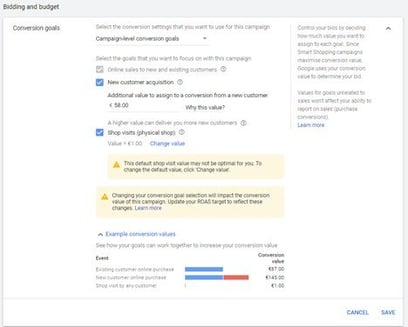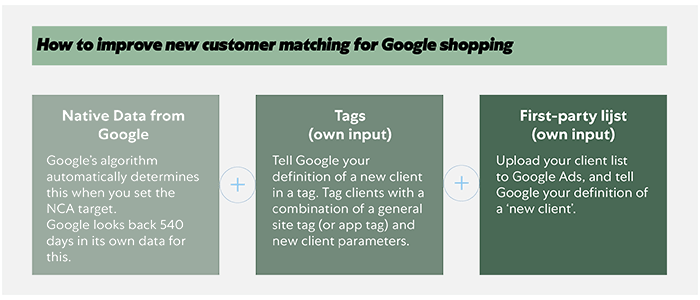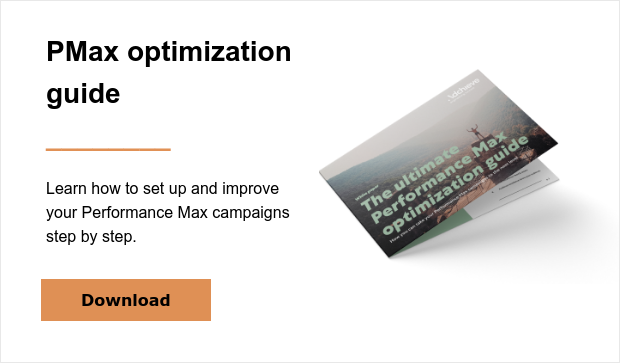Be aware: Google has introduced a new campaign type that will replace Smart Shopping: Performance Max (Pmax). All Smart Shopping Campaigns will automatically be migrated to PMax campaigns, starting July 2022.
Read more about Performance Max here, or download our whitepaper for more in-depth information.
How does New Customer Acquisition Goals in Google Ads work?
First of all, I would like to tell you what the new position entails. With New Customer Acquisition Goals (NCA), you can assign extra value to a conversion of a new customer in Google Ads. An example: you think that a new customer is worth 100 euros more than a returing customer, because you know that the chance that they will buy from you again is high.
For example, with NCA you can now enter €100 as extra value for a new customer. If a new customer orders €200 worth of items, the conversion is now worth €300. This means that your campaigns will bid significantly more for new customers. As a result, you will also reach significantly more new customers, but, of course, your advertising costs will also increase.

How does Google recognise your ‘New Customer’?
First of all, you have to define who sees Google as a new customer. Google uses its own data for this, but recommends supplementing this with your own data, because the more data; the more accurate the targeting will be. The image below shows you how to improve new customer matching for Google shopping:

New Customer Acquisition Goals: the Benefits and the ‘Dangers’
I will discuss the benefits, but also the ‘dangers’ of Google Performance Max in general. This campaign type, which uses automatic bidding and ad placements to promote your products across all Google networks.
Performance Max has many advantages: it is easy to set up, easy to manage, you have a large reach, it uses all the signals that Google uses for smart bidding and offers during the auction (auction-time bidding) with a powerful, self-learning algorithm.
Algorithms do not measure incremental uplift
One of the biggest criticisms of Performance Max (and before Pmax: Smart Shopping) campaigns, on the other hand, is the tendency of the algorithms to focus on your existing customers or customers who have interacted with your site or brand before. After all, the algorithms optimize for the chance of a conversion, and not for the incremental uplift.
In other words: the algorithms cannot distinguish between the selection effect (people click on your ad, but would have bought from you anyway) and the ad effect (people click on your ad and buy from you thanks to that ad).
Google has made Performance Max non-transparent (Google itself indicates that it wants to make it easier) by removing search term data and data about the remarketing share from the reports. This means that you cannot see the percentage of clicks that have come in via your own brand name or, for example, via a remarketing banner on YouTube or the Google Display Network (GDN).
What should I pay attention to when setting New Customer Acquisition Goals?
Following on from these criticisms: Our American colleague Kirk Williams (Zato Marketing) immediately saw two major criticisms of the new feature: 1) the selection effect will remain and 2) your reports will give a wrong (bloated) representation of the results. A third point of criticism is that the objectives are difficult to determine. I explain these points one by one below:
Selection effect persists
Anyone who expected NCA to bypass the selection effect will be disappointed. In the case of NCA, it is not about people who have visited your site before or people who looked up your brand name. Only people who have not purchased anything from you in the past 540 days (according to your tracking) are considered as a ‘new customer’. A large part of the selection bias therefore remains with this new feature.
Reports provide incorrect insight
The conversion value for a new customer is above the conversion value of the order. The reports in Google Ads will change and give a wrong picture of the turnover you have achieved.
If you link a higher value to new customers, your total value will be higher than your actual revenue. Wherever you allocate something more, you should also be able to deduct something. Because if such a new customer, to which you have already assigned some lifetime value, comes back later, you should associate less value with it.
For the time being, this is not yet broken down into a separate column in Google Ads, so this means that you cannot yet analyse/compare this separately.
So make sure you don’t count yourself, and especially Google, rich. For example, an advertising agency could quite easily misrepresent the results achieved. What prevents them from awarding a hefty sum to a new customer and shining with the results?
Setting goals is difficult
Adding value to new customers does not automatically decrease value for existing customers. In order to arrive at the same value/cost ratio, you will therefore have to adjust your default ROAS target. It is very difficult to make a good estimate of this. Some important questions you should ask yourself are:
- What is the current relationship between new customers and (traced) existing customers?
- How much is a new customer really worth?
- What is the average order value of a new and existing customer?
- What is the chance that a customer will buy something from you again and what would be the value of this behaviour?
- How many of the customers would have bought from you regardless?
In conclusion: New Customer Acquisition goals in Google Ads is a handy feature for Performance Max campaigns that allows you to easily reach more new customers via all Google networks. However, NCA entails a number of pitfalls: the selection effect will persist, reports will show an inflated representation of the results, and finally it remains difficult to determine the correct objectives.


